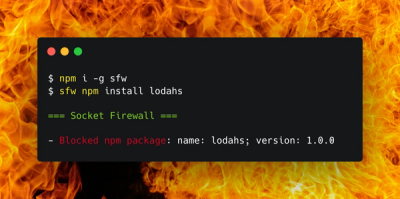
Security News
PodRocket Podcast: Inside the Recent npm Supply Chain Attacks
Socket CEO Feross Aboukhadijeh discusses the recent npm supply chain attacks on PodRocket, covering novel attack vectors and how developers can protect themselves.
@rbxts/silo
Advanced tools
State management based on Redux slices.
Creating a new silo is easy. Define the state and modifiers, and then create the silo via
createSilo(), passing along the initial state and the modifier implementations.
// Define the shape of the state:
interface MyState {
kills: number;
points: number;
}
// Define the modifier actions:
interface MyModifiers {
addKill: (state: MyState) => MyState;
addPoints: (state: MyState, points: number) => MyState;
}
// Create the Silo:
const mySilo = createSilo<MyState, MyModifiers>(
{
// Default state:
kills: 0,
points: 0,
},
{
// Modifier implementations:
addKill: (state) => {
return {
...state,
kills: state.kills + 1,
};
},
addPoints: (state, points) => {
return {
...state,
points: state.points + points,
};
},
},
);
Modifiers can be accessed through the actions property of a silo. Actions are functions
that are identical to the modifier implementation, except the first state argument is
dropped, since the silo can inject that itself.
For instance, to use the addKill and addPoints modifiers, we can call the resulting actions
as mySilo.actions.addKill and mySilo.actions.addPoints:
// Add kill:
mySilo.actions.addKill();
// Add 15 points:
mySilo.actions.addPoints(15);
Use the getState() function to get the current state of a silo.
print(mySilo.getState());
print(`Points: ${mySilo.getState().points}`);
Use the subscribe function to subscribe to all future changes to the entire state, which
will also include a copy of the old state.
Use the observe function to observe a specific selection of the state, which will then fire
the given observer function anytime the selection changes, including the immediate value.
Observers can optionally be given a changed callback, which will control whether or not the
observer is triggered. Any time the silo's state changes, the changed callback will be given
the new and old value of the selector, and the callback must return whether or not the value
has changed. This is useful for checking for table value changes or other dynamic changes that
go beyond the default old !== new comparison.
// Subscribe to changes to the state:
mySilo.subscribe((newState, oldState) => {
print("State changed");
});
// Observe points:
mySilo.observe((state) => state.points, (points) => {
print(`Points: ${points}`);
});
// Observing state with a specified `changed` callback:
mySilo.observe(
(state => state.points),
(points) => print(points),
// Only trigger observer if points have changed by more than 5:
(newPoints, oldPoints) => math.abs(newPoints - oldPoints) > 5,
);
// The `subscribe` and `observe` functions return functions that can be called
// in order to stop subscribing/observing:
const unsubscribe = mySilo.subscribe((newState, oldState) => {});
unsubscribe();
const stopObserving = mySilo.observe((state) => state.points, (points) => {});
stopObserving();
If a silo needs to be cleaned up during runtime, call the destroy() function on the silo.
All this function does is clear out the subscriber/observer list internally.
mySilo.destroy();
It is common to have more than one silo. Use the combineSilo function to create a wrapper
silo around multiple silos. The individual silos can still be used, but the combined silo
can be used to help manage and observe state.
// Assuming we have the `mySilo` from the first example.
interface AnotherState { message: string }
interface AnotherModifiers {
setMessage: (state: AnotherState, msg) => AnotherState;
}
const anotherSilo = createSilo<AnotherState, AnotherModifiers>(
{ message: "" },
{ setMessage: (state, msg) => ({...state, message: msg}) },
);
// Combine `mySilo` and `anotherSilo`:
const silos = combineSilos({
my: mySilo,
another: anotherSilo,
});
// Calling `getState()` returns a combined state of all silos:
print(`Message: ${silos.getState().another.message}`);
// Individual silos can also be accessed through the `all` property:
print(`Message: ${silos.all.another.getState().message}`);
// Observe the current message & future changes to the message:
silos.observe((state) => state.another.message, (msg) => {
print(`Observing message: ${msg}`);
});
// Set a message:
silos.all.another.actions.setMessage("Hello world");
FAQs
State management
We found that @rbxts/silo demonstrated a not healthy version release cadence and project activity because the last version was released a year ago. It has 1 open source maintainer collaborating on the project.
Did you know?

Socket for GitHub automatically highlights issues in each pull request and monitors the health of all your open source dependencies. Discover the contents of your packages and block harmful activity before you install or update your dependencies.

Security News
Socket CEO Feross Aboukhadijeh discusses the recent npm supply chain attacks on PodRocket, covering novel attack vectors and how developers can protect themselves.

Security News
Maintainers back GitHub’s npm security overhaul but raise concerns about CI/CD workflows, enterprise support, and token management.

Product
Socket Firewall is a free tool that blocks malicious packages at install time, giving developers proactive protection against rising supply chain attacks.